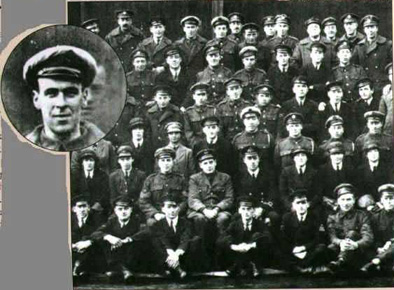 The following is an article from Bathroom Readers' Institute's Uncle John's Great Big Bathroom Reader.
The following is an article from Bathroom Readers' Institute's Uncle John's Great Big Bathroom Reader.
The werewolf is one of the most recognized movie monsters in history, thanks in large part to the 1941 film The Wolf Man, starring Lon Chaney, Jr. Here's a behind-the-scenes look at the making of that classic film.
FRIGHT FACTORY
The early 1930s was the golden age of movie monsters. In 1930, Universal released the classic Dracula, starring Bel Lugosi; a year later it had another huge hit with Boris Karloff's Frankenstein. Inspired by their success, Universal decided to make a movie about a werewolf.
In 1931, they handed writer/director Robert Florey a title -The Wolf Man- and told him to come up with an outline. A few months later, Florey submitted notes for a story about a Frenchman who has suffered for 400 years under a witch's curse that turns him into a werewolf during every full moon ...unless he wears a garland of wolf-bane around his neck. The studio approved the idea and scheduled the movie as a Boris Karloff vehicle for 1933. A shooting script was written ...and rewritten ...and rewritten several more times. By the time it was finished, the script was about an English doctor who was bitten by a werewolf in Tibet, then turns into one himself on his return to London. Universal renamed the pictures Werewolf of London.
BAT MAN
 By now, however, Boris Karloff was too busy to take the part ...So it went a Broadway actor named Henry Hull. Werewolf of London hit theaters in 1935. The movie wasn't very good: One critic has called it "full of fog, atmosphere, and laboratory shots, but short on chills and horror." That was largely because Hull didn't look scary. He refused to cover his face with werewolf hair, complaining that it obscured his features. Makeup man Jack Pierce -already a legend for creating Bela Lugosi's Dracula and Boris Karloff's Frankenstein- had no choice but to remove most of the facial hair, leaving Hull looking like a demonic forest elf. Werewolf of London was a box office disappointment. It was also Hull's last werewolf film.
By now, however, Boris Karloff was too busy to take the part ...So it went a Broadway actor named Henry Hull. Werewolf of London hit theaters in 1935. The movie wasn't very good: One critic has called it "full of fog, atmosphere, and laboratory shots, but short on chills and horror." That was largely because Hull didn't look scary. He refused to cover his face with werewolf hair, complaining that it obscured his features. Makeup man Jack Pierce -already a legend for creating Bela Lugosi's Dracula and Boris Karloff's Frankenstein- had no choice but to remove most of the facial hair, leaving Hull looking like a demonic forest elf. Werewolf of London was a box office disappointment. It was also Hull's last werewolf film.
SECOND TRY
In the early 1940s, Universal launched a second wave of horror films featuring Dracula, Frankenstein, and other classic monsters. They decided to give the werewolf another try, too. This second werewolf film started the same way the first one did: with the title The Wolf Man. This time the scriptwriter was Curt Siodmak. He started from scratch, researched werewolf legends himself, and used what he learned to write the script. The story he concocted was about an American named Lance Talbot who travels to his ancestral home in Wales and is bitten while rescuing a young woman from a werewolf attack.
Once again, the studio wanted to cast Karloff in the lead ...and once again he was too busy to take it. They considered Bela Lugosi, but he was too old for the part. So they gave it to newcomer Lon Chaney, Jr., son and namesake of the greatest horror star of the silent movie era. Chaney, Sr. was known all over the world as the "Man of 1000 Faces," for his roles in The Phantom of the Opera and The Hunchback of Notre Dame. Chaney, Jr. had recently starred in Man Made Monster, and Universal thought he had potential in horror films.







 The following is an article from Bathroom Readers' Institute's Uncle John's Great Big Bathroom Reader.
The following is an article from Bathroom Readers' Institute's Uncle John's Great Big Bathroom Reader.  By now, however, Boris Karloff was too busy to take the part ...So it went a Broadway actor named Henry Hull. Werewolf of London hit theaters in 1935. The movie wasn't very good: One critic has called it "full of fog, atmosphere, and laboratory shots, but short on chills and horror." That was largely because Hull didn't look scary. He refused to cover his face with werewolf hair, complaining that it obscured his features. Makeup man Jack Pierce -already a legend for creating Bela Lugosi's Dracula and Boris Karloff's Frankenstein- had no choice but to remove most of the facial hair, leaving Hull looking like a demonic forest elf. Werewolf of London was a box office disappointment. It was also Hull's last werewolf film.
By now, however, Boris Karloff was too busy to take the part ...So it went a Broadway actor named Henry Hull. Werewolf of London hit theaters in 1935. The movie wasn't very good: One critic has called it "full of fog, atmosphere, and laboratory shots, but short on chills and horror." That was largely because Hull didn't look scary. He refused to cover his face with werewolf hair, complaining that it obscured his features. Makeup man Jack Pierce -already a legend for creating Bela Lugosi's Dracula and Boris Karloff's Frankenstein- had no choice but to remove most of the facial hair, leaving Hull looking like a demonic forest elf. Werewolf of London was a box office disappointment. It was also Hull's last werewolf film. 
















